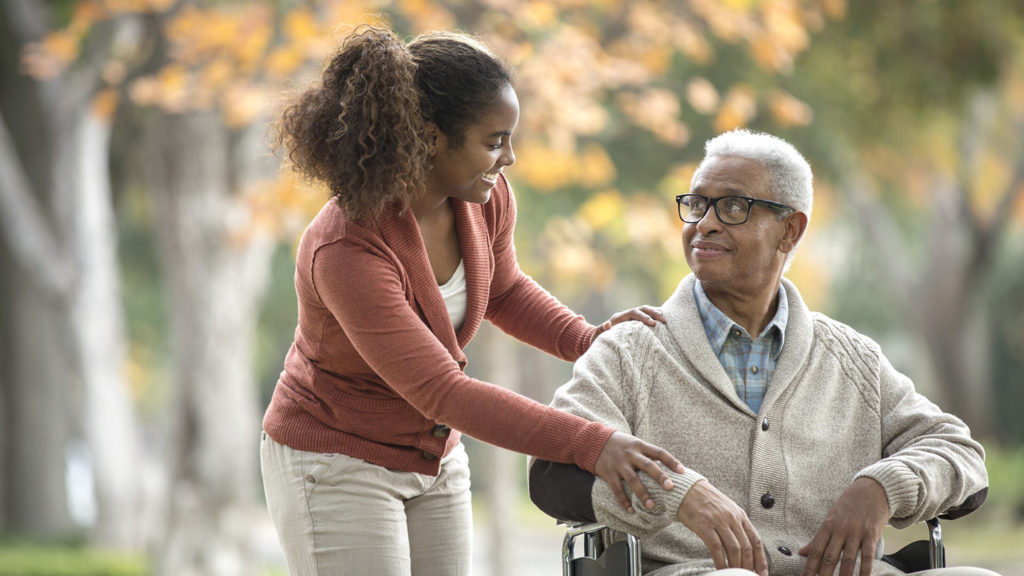
Relatives of senior living residents are among those who are a focus of what the federal government is calling its first national strategy to support family caregivers. But the new strategy also calls for efforts to address professional caregiver education, training and compensation; to establish a pipeline of workers for long-term care; and to reform the long-term services and supports financing system.
In addition to federal action, the strategy proposes moves at the state and local levels.
The U.S. Department of Health and Human Services, through its Administration for Community Living, which includes the Administration on Aging, last week released the 2022 National Strategy to Support Family Caregivers. It highlights the almost 350 actions that the federal government says it will take to support family caregivers over the next three years as well as more than 150 actions that can be adopted at other levels of government and across the private sector, including healthcare systems and LTSS providers.
The affected family caregivers, according to a 102-page overview and description of the strategy, include those who support “[p]eople who live in nursing homes, board-and-care, and assisted living facilities, and other residential care communities.” The family caregivers, the document noted, provide assistance for residents to “maintain their health, safety, welfare, and well-being.”
“Many of the more than 150 million people who receive healthcare coverage through Medicare, Medicaid and the health insurance marketplaces rely on trusted friends and family for care,” CMS Administrator Chiquita Brooks-LaSure said in a statement. “CMS is committed to advancing home- and community-based services and other forms of caregiver support across the lifespan to give caregivers the recognition and resources they need and deserve.”
‘Elevating direct care workers’
A component of the strategy called “First Principles: Cross-Cutting Considerations for Family Caregiver Support” calls for “elevating direct care workers as family caregiving partners.” That document maintains that six practices must be embedded in all caregiver support to strengthen the direct care workforce. Those practices:
- Enhance education and training so professional caregivers will feel well-prepared to carry out increasingly complex care tasks, and so assisted living communities, nursing homes, home care organizations, consumers and their families will have confidence in them.
- Prepare universal workers who could become direct care professionals in assisted living communities, home- and community-based settings, nursing homes and other settings.
- Expand the pipeline of potential caregivers by recruiting nontraditional workers to the long-term care field and by changing immigration policy so more caregivers will seek jobs in long-term care.
- Provide access to career ladders that offer opportunities beyond the traditional nursing path, including careers in social work, therapy and management positions that use their relationship skills.
- Increase compensation so that direct care professionals can earn “at least a living wage.”
- Reform the LTSS financing system by using insurance-based dollars to provide “additional and more consistent funding” for LTSS and to help ensure that the LTSS workforce receives “adequate compensation.”
The strategy was created through a public-private partnership and with support from the LeadingAge LTSS Center @UMass Boston, the John A. Hartford Foundation, the National Academy for State Health Policy, Community Catalyst and the National Alliance for Caregiving.
Advisory councils established by the Recognize, Assist, Include, Support, and Engage Family Caregivers Act and the Supporting Grandparents Raising Grandchildren Act received “extensive” input from family caregivers, the people they support and other stakeholders, according to HHS. The ACL leads implementation of the RAISE and SGRG acts and facilitates the work of the two advisory councils.
“This strategy presents a vision, along with recommendations for achieving it,” Acting ACL Administrator and Assistant Secretary for Aging Alison Barkoff said in a statement. “Bringing that vision to life will require contributions and commitments from every sector, every level of government — and all of us — and ACL is proud to help lead that work.”
HHS said that the strategy represents the first time a broad cross-section of the federal government has collaborated with the private sector on a response to “the longstanding national need for a comprehensive system of family caregiver support.”
“Supporting family caregivers is an urgent public health issue, exacerbated by the long-term effects of the COVID-19 pandemic. This national strategy recognizes the critical role family caregivers play in a loved one’s life,” HHS Secretary Xavier Becerra said in a statement, adding, “I know the importance of this first-hand, as someone who cared for my late father and navigated the challenges associated with caregiving.”
The strategy will be updated every two years, according to HHS. The updates will be based on public input as well as the work of the advisory councils, communities, states, tribes and federal agencies.
The strategy has been delivered to the U.S. Senate Committee on Health, Education, Labor and Pensions and the U.S. House Committee on Education and Labor as well as to state agencies responsible for carrying out family caregiver programs.
Starting Oct. 1, the public can comment at acl.gov/CaregiverStrategy/Comments.
